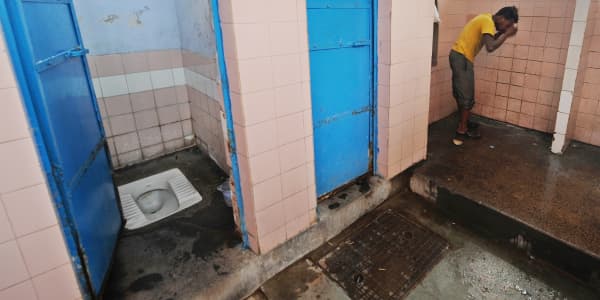The U.S. has a growing water supply problem, according to a new study.
Nearly 1 in 10 of the nation's watersheds—areas of land that contain runoff from rivers and streams—are stressed to the point to where demand for water exceeds the natural supply.
"There is a lot of pressure on our water supply, especially In the western part of the country," said Kristen Averyt, associate director for science at the Cooperative Institute for Research in Environmental Sciences, and lead author of the report released this month.
"As the population grows, so too does demand. We expect to have less surface water supplies in several areas of the U.S. by 2050," she added.
The report analyzes supplies and demand over the past 10 years for the 2,103 watersheds in the continental U.S. and found that 193 were stressed, meaning their supply of water for use was less than the demand.
The report said that the western U.S. is most vulnerable to water stress because the area relies on stored water as well as imports of water from rivers and streams—and the difference between demand and supply is so small that a slight shift in either can trigger shortages.
Because agriculture requires the most water—some 70 percent of all water use in the U.S.—it's a major contributing factor to water stress in the country, said the report. And the report states that in certain sections of the U.S., the use of cooling water by electrical power plants places yet another big demand on water supplies.
(Read more: )
A survey by the research group EIRIS found that under current business conditions, water demand will outstrip supply by 2030—and will potentially put $63 trillion of global gross domestic product at risk by 2050.
"Along with agriculture, the use of water for electrical supply from power plants could force us into a tipping point on water demand," Averyt argued.
Another wake up call
Warnings over a dwindling global water supply are not new. But this latest study is another wake-up call for the U.S., said Christiana Peppard, a professor of environmental ethics at Fordham University.
"What it does is emphasize that we ought to be thinking differently in sectors like agriculture and electricity generation when it comes to water use," Peppard said.
"We don't realize how much water goes into making things—what's called 'virtual water,'" said Peppard.
Whether it's for showering or cooking, Americans use on average 2,000 gallons of water a day, according to the Waterfootprint Network. That's double the global average.
But water used to make products—the so-called virtual water—can be be very extensive. One pair of blue jeans, for instance, takes more than 2,600 gallons of water to produce, according to Waterfootprint. It takes 6,300 gallons of water to make 2.5 pounds of chocolate. An eight-ounce cup of coffee uses up 36.5 gallons of water in production.
(Read more:
"We're seeing how economic areas are contributing to the water shortages," said Christopher Williams, professor of geography at Clark University.
"I think there will be a lot of tension between sectors for water in the future," Williams said.
"The Western U.S. is in a chronic state of water shortage from droughts," Williams added. "People could be competing with agriculture for water. I think there could be some areas of the country that won't produce any agricultural products that do now because of a lack of water."
Another threat to the water supply, said Fordham's Peppard, is the spreading use of hydraulic fracking, which combines chemicals and water for drilling.
"Fracking uses a lot of water in the process to get gas and oil out of the ground," she said. "And it's consumptive, meaning that the water can't be used again."
'Like an engine light going off'

One possible solution to avert a water shortage is having two types of water and finding nonconsumptive water—water that can be used again, said Jose Lopez, professor of physics at Seton Hall University.
"We could have one supply of water for drinking and one to water the lawn," said Lopez. "The one for the lawn could be used water or what's also called 'gray water,' water that's been more or less recycled and not wasted."
"Cities out West are already doing something about their water issues," Lopez said. "They're putting a lot of work into this. It's something the rest of the country can learn from."
(Read more: )
"A lot of our infrastructure is younger than the rest of the country, but we have begun repairing reservoirs and other parts of our water system," said Scott Huntley, a spokesman for the Las Vegas Water Valley District, a public entity of Nevada.
"We had leaks, so we decided to get a jump on this by fixing them," Huntley said. "It's a conscious effort on our part not to fall behind."
In the end, what's important from this study or any other is to start taking action, say analysts.
"I think the clock is ticking on the things we need to be aware of and do when it comes to water," said Lopez.
"This is like the engine light going off in a car," said CIRE's Averyt. "It could mean the tire pressure is low or the engine is about to blow up. What it means is that we need to take a close look on what's happening to our water supply."
—By CNBC's Mark Koba. Follow him on Twitter @MarkKobaCNBC





